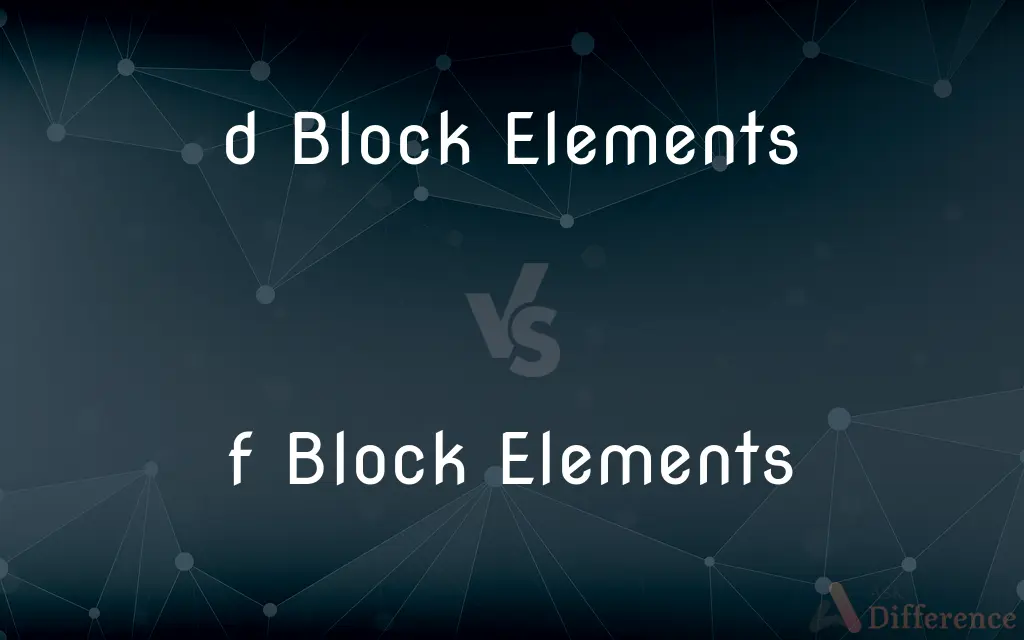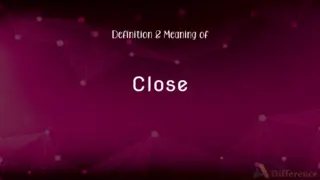d Block Elements vs. f Block Elements — What's the Difference?
By Tayyaba Rehman — Published on December 27, 2023
d Block Elements are transition metals found in groups 3-12 of the periodic table, while f Block Elements consist of lanthanides and actinides, often positioned below the main table.

Difference Between d Block Elements and f Block Elements
Table of Contents
ADVERTISEMENT
Key Differences
d Block Elements, often known as transition metals, are positioned in groups 3-12 of the periodic table. These elements characteristically have their d-orbitals being filled progressively. They exhibit multiple oxidation states and are typically good conductors of heat and electricity. On the other hand, f Block Elements comprise the lanthanides and actinides series, which are typically positioned below the main body of the periodic table due to their extensive properties.
Both d Block Elements and f Block Elements play vital roles in various applications. While d Block Elements are often used in catalysis, alloy formation, and colored compound production due to their variable oxidation states, f Block Elements, especially the actinides, are significant in the nuclear industry, given their radioactive properties.
In terms of electronic configuration, d Block Elements have electrons filling up their d-orbitals. In contrast, f Block Elements have their f-orbitals being filled. This distinct electronic configuration contributes to the unique properties of both sets of elements. For instance, many d Block Elements are known for their magnetic properties, while f Block Elements have a high density and are hard metals.
Interestingly, while d Block Elements are generally stable and less reactive than s Block Elements, many f Block Elements, especially the actinides, are radioactive and can be hazardous. This distinction becomes evident when considering elements like gold (a d Block Element) that doesn't tarnish, compared to uranium (an f Block Element), which is radioactive.
Lastly, the study and understanding of d Block Elements and f Block Elements is crucial for advanced chemical applications. For instance, d Block Elements like platinum are used as catalysts in fuel cells, whereas f Block Elements like europium are employed in fluorescent lights.
ADVERTISEMENT
Comparison Chart
Position on Periodic Table
Found in groups 3-12.
Positioned below the main table.
Orbital Being Filled
D-orbitals.
F-orbitals.
Examples
Iron, Copper, Gold.
Lanthanum, Uranium, Thorium.
Common Uses
Catalysts, alloys, colored compounds.
Nuclear industry, some are used in fluorescent lights.
Reactivity
Generally stable and less reactive than s Block.
Many, especially actinides, are radioactive.
Compare with Definitions
d Block Elements
Elements with electrons filling up their d-orbitals.
Iron, a d Block Element, is essential for hemoglobin in blood.
f Block Elements
Elements with electrons filling their f-orbitals.
Uranium, an f Block Element, is crucial for nuclear power generation.
d Block Elements
Also known as transition metals.
Copper, a d Block Element, is widely used in electrical wiring.
f Block Elements
Comprise the lanthanides and actinides series.
Neodymium, an f Block Element, is used in powerful permanent magnets.
d Block Elements
Positioned in groups 3-12 of the periodic table.
Zinc, a d Block Element, is important for numerous biochemical processes.
f Block Elements
Many are radioactive, especially among the actinides.
Plutonium, an f Block Element, is highly radioactive and used in nuclear weapons.
d Block Elements
Characteristically good conductors of heat and electricity.
Silver, a d Block Element, has one of the highest electrical conductivities among metals.
f Block Elements
Characterized by high densities and are hard metals.
Lanthanum, an f Block Element, is used in making special optical glasses.
d Block Elements
Exhibit variable oxidation states.
Manganese, a d Block Element, can show multiple oxidation states ranging from +2 to +7.
f Block Elements
Often found below the main periodic table.
Cerium, an f Block Element, finds applications in catalysis.
Common Curiosities
What are d Block Elements?
d Block Elements, or transition metals, are found in groups 3-12 of the periodic table with electrons filling their d-orbitals.
Where are f Block Elements positioned?
f Block Elements consist of lanthanides and actinides and are typically positioned below the main periodic table.
What is a common use of d Block Elements?
They are often used in making alloys, as catalysts, and in colored compounds.
Why are d Block Elements called transition metals?
Because they exhibit multiple oxidation states and transition between them.
Are all f Block Elements radioactive?
Not all, but many, especially in the actinides series, are radioactive.
What makes f Block Elements unique?
They have their f-orbitals being filled, and many possess radioactive properties.
Why are actinides significant in the nuclear industry?
Many actinides, which are f Block Elements, are radioactive and are used as fuel in nuclear reactors.
Which d Block Element is the best conductor of electricity?
Silver, a d Block Element, is among the best conductors of electricity.
How do d Block Elements differ from s Block Elements?
d Block Elements are transition metals with variable oxidation states, while s Block includes alkali and alkaline earth metals.
Are all f Block Elements hard metals?
Many f Block Elements are characterized by high densities and are hard metals, but there are exceptions.
Are d Block Elements magnetic?
Many d Block Elements exhibit magnetic properties due to unpaired d-electrons.
What are lanthanides in f Block Elements used for?
Lanthanides, part of the f Block Elements, are used in various applications, from electronics to phosphors in screens.
Which f Block Element is commonly used in magnets?
Neodymium, an f Block Element, is used in the production of strong permanent magnets.
Are d Block Elements reactive?
While d Block Elements are generally stable, they can react under specific conditions, especially with oxygen and acids.
Which d Block Element is essential for life?
Iron, a d Block Element, is essential for oxygen transport in blood.
Share Your Discovery

Previous Comparison
Pittsburgh Style Steak vs. Black and Blue Steak
Next Comparison
Descriptive Statistics vs. Inferential StatisticsAuthor Spotlight
Written by
Tayyaba RehmanTayyaba Rehman is a distinguished writer, currently serving as a primary contributor to askdifference.com. As a researcher in semantics and etymology, Tayyaba's passion for the complexity of languages and their distinctions has found a perfect home on the platform. Tayyaba delves into the intricacies of language, distinguishing between commonly confused words and phrases, thereby providing clarity for readers worldwide.










































